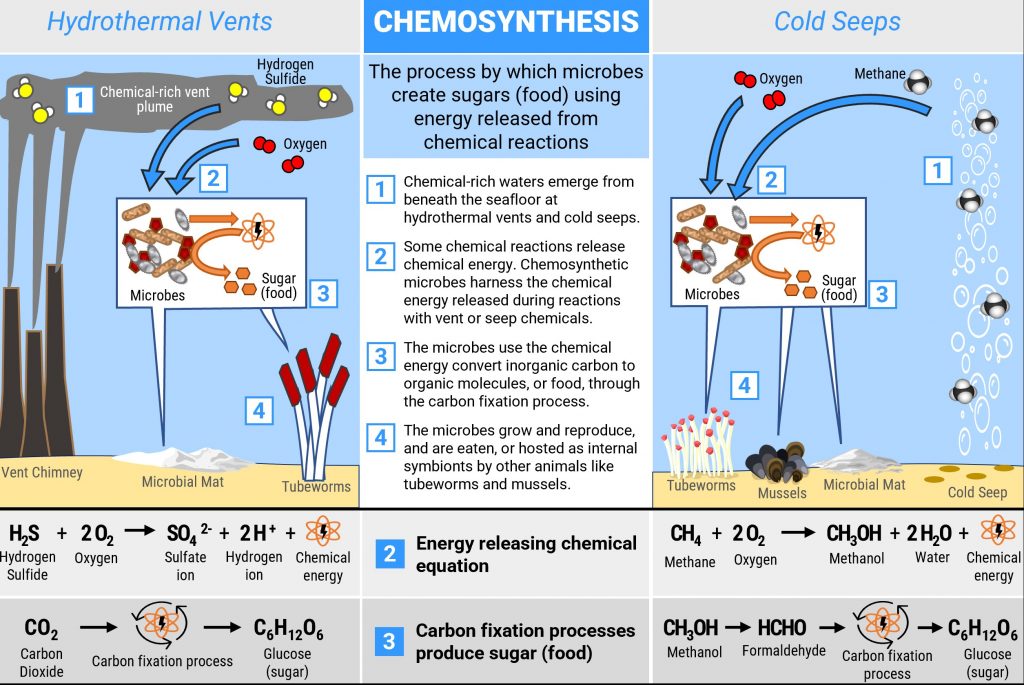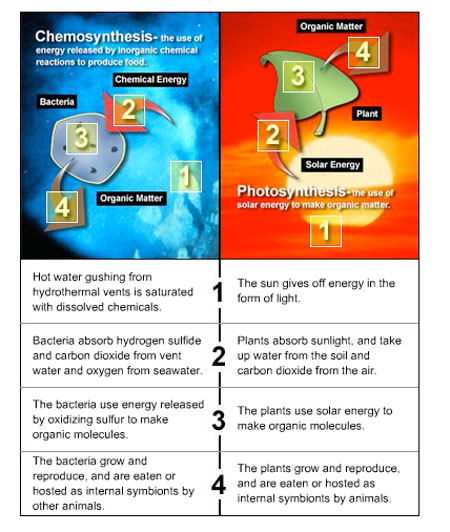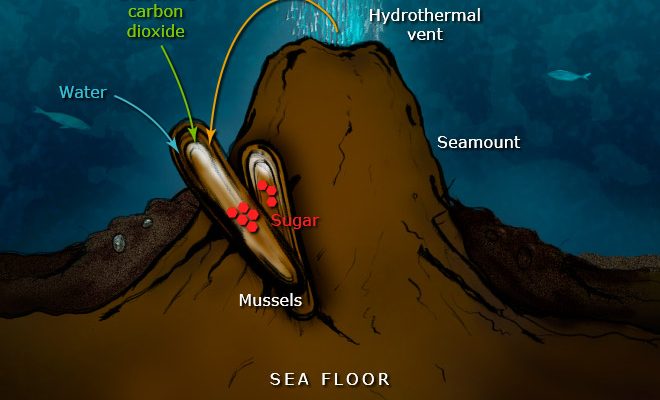Chemosynthesis is a remarkable process that plays a crucial role in sustaining life in unique and extreme environments.
Table of Contents
Definition of Chemosynthesis
Chemosynthesis is a biological process by which certain microorganisms, called Chemosynthetic organisms, obtain energy by converting inorganic compounds into organic compounds. Unlike photosynthesis, which relies on sunlight as an energy source, Chemosynthesis uses the energy released by chemical reactions involving inorganic compounds such as hydrogen sulphide (H2S), methane (CH4) or iron compounds. These energy-rich organic compounds synthesised through Chemosynthesis serve as a source of energy and nutrients for the organisms that carry out the process. Chemosynthesis typically occurs in environments where sunlight is limited or absent, such as deep-sea hydrothermal vents, cold seeps, and certain underground ecosystems. This process plays a crucial role in sustaining life and supporting various ecosystems in extreme environments.
Also Check – Types of Autotrophic Nutrition – Chemosynthesis and Photosynthesis
The Process of Chemosynthesis

Chemosynthetic Organisms
Chemosynthesis is primarily carried out by specialised microorganisms, including Chemosynthetic bacteria, archaea, and other organisms. These remarkable life forms are capable of harnessing energy from inorganic chemical compounds instead of relying on sunlight, as is the case in photosynthesis.
Chemosynthesis Equation
The process of Chemosynthesis can be summarised by the following equation-
6CO2 + 6H2O + inorganic compounds (e.g. hydrogen sulphide) → C6H12O6 (organic compounds) + 6H2O + sulphur compounds (e.g. sulphates)
In this equation, carbon dioxide (CO2) serves as the carbon source, while water (H2O) acts as the source of hydrogen atoms. The inorganic compounds, such as hydrogen sulphide (H2S) found in hydrothermal vents, methane (CH4), or iron compounds, act as the energy source.
Chemical Reactions
Chemosynthesis involves a series of chemical reactions within the specialised cells of Chemosynthetic organisms. The specific reactions may vary depending on the type of organism and the inorganic compounds present in their environment.
For example, in hydrothermal vent ecosystems, Chemosynthetic bacteria utilise hydrogen sulphide (H2S) as an energy source. The bacteria oxidise the hydrogen sulphide, releasing electrons and energy in the process. This energy is used to convert carbon dioxide (CO2) and water (H2O) into organic compounds, such as sugars or carbohydrates, through a series of enzymatic reactions. The overall reaction can be represented as-
6CO2 + 6H2O + 3H2S → C6H12O6 + 3H2SO4
In this reaction, carbon dioxide, water, and hydrogen sulfide are converted into glucose (C6H12O6) and sulfuric acid (H2SO4). The glucose serves as an energy-rich organic compound that can be used by the organism, while sulfuric acid is a by-product.
Nutrient Synthesis
Through the process of Chemosynthesis, these microorganisms are capable of synthesizing their own nutrients. The organic compounds produced serve as a source of energy and nutrients for the organisms themselves and may support the growth and survival of other organisms in the ecosystem.
Chemosynthetic bacteria
Chemosynthetic bacteria are specialised microorganisms that have adapted to thrive in extreme environments where sunlight is limited or absent. They are found in locations such as hydrothermal vents and cold seeps, which are characterised by high temperatures, pressure, and chemical toxicity. These bacteria possess unique characteristics and adaptations that enable them to survive and carry out Chemosynthesis.
Characteristics of Chemosynthetic Bacteria
- Tolerance to Extreme Conditions – Chemosynthetic bacteria have evolved to tolerate and thrive in extreme conditions. They can withstand high temperatures found in hydrothermal vents, which can reach several hundred degrees Celsius, as well as the cold temperatures in deep-sea cold seeps. Additionally, they are adapted to high pressures associated with these environments.
- Chemical Adaptations – Chemosynthetic bacteria have developed mechanisms to cope with the chemical toxicity present in their habitats. They possess enzymes and membrane transport proteins that enable them to withstand and utilise chemicals such as hydrogen sulphide, methane, iron, and sulphur compounds, which serve as their energy sources.
Also Check – Difference Between Chemosynthesis and Photosynthesis
Types of Chemosynthetic Bacteria
Sulphur Bacteria- Sulphur bacteria are a common type of Chemosynthetic bacteria that utilise inorganic sulphur compounds, such as hydrogen sulphide (H2S), as an energy source. They oxidise these compounds to produce energy-rich organic molecules. Examples of sulphur bacteria include Thiobacillus and Beggiatoa.
Iron Bacteria– Iron bacteria are another group of Chemosynthetic bacteria that derive energy from iron compounds. They can oxidise ferrous iron (Fe2+) or reduce ferric iron (Fe3+) to obtain energy for Chemosynthesis. Acidithiobacillus ferrooxidans is an example of an iron bacteria.
Nitrifying Bacteria- Nitrifying bacteria are Chemosynthetic bacteria involved in the nitrogen cycle. They obtain energy by oxidising ammonia (NH3) to nitrite (NO2-) and further to nitrate (NO3-). Nitrosomonas and Nitrobacter are common examples of nitrifying bacteria.
Examples of Chemosynthetic Bacteria

Hydrothermal Vent Bacteria- Bacteria found in hydrothermal vent ecosystems, such as the genera Riftia and Bathymodiolus, are fascinating examples of Chemosynthetic bacteria. These bacteria form symbiotic relationships with host organisms, particularly tube worms and mussels. The bacteria reside within the hosts and provide them with organic compounds, while receiving shelter and protection in return. The process of Chemosynthesis within these symbiotic relationships sustains the entire ecosystem surrounding the hydrothermal vents.
Nutritional Aspects of Chemosynthesis
Energy Production through Chemosynthesis-
Chemosynthesis provides a valuable source of energy for organisms residing in environments devoid of sunlight. The process allows Chemosynthetic bacteria and other organisms to convert inorganic compounds into organic compounds, which serve as a source of energy and nutrients.
Trophic Levels and Food Chains in Chemosynthetic Ecosystems-
Chemosynthetic ecosystems have unique food chains that revolve around the energy produced through Chemosynthesis. Primary producers, such as Chemosynthetic bacteria, form the basis of these food chains, supporting higher trophic levels and contributing to the overall biodiversity of these ecosystems.
Comparison with Traditional Food Chains-
While Chemosynthesis-based food chains differ from traditional photosynthesis-based food chains, both are essential components of Earth’s ecosystems. Understanding the interplay between these two processes provides valuable insights into the diversity and stability of ecological systems.
Also Check – Nutrition in Plants
Chemosynthesis vs. Photosynthesis

Similarities between Chemosynthesis and Photosynthesis
- Synthesis of Organic Compounds- Both Chemosynthesis and photosynthesis involve the synthesis of organic compounds. Organic compounds, such as carbohydrates, lipids, and proteins, are essential for the growth, development, and energy storage of organisms.
- Contribution to the Global Carbon Cycle- Both processes play a vital role in the global carbon cycle. During Chemosynthesis, Chemosynthetic bacteria convert inorganic carbon dioxide (CO2) into organic carbon compounds, effectively removing CO2 from the environment. Similarly, photosynthesis in plants and algae captures atmospheric CO2 and incorporates it into organic compounds, thereby reducing atmospheric carbon dioxide levels.
- Support for Organism Survival- Chemosynthesis and photosynthesis provide a foundation for the survival and sustenance of diverse organisms. Chemosynthetic bacteria form the basis of unique ecosystems in extreme environments, such as hydrothermal vents and cold seeps, providing a source of energy and nutrients for other organisms. Photosynthesis in plants and algae produces oxygen as a byproduct, which is essential for the survival of many organisms, including humans.
Also Check – Autotrophic Nutrition – Significance ,Types, Organisms and Examples
Differences in Energy Sources and Chemical Reactions
Energy Sources
- The key distinction between Chemosynthesis and photosynthesis lies in the energy sources they utilise.
- Photosynthesis relies on sunlight as the primary energy source. Sunlight is absorbed by pigments, such as chlorophyll, and is converted into chemical energy through a series of light-dependent reactions.
- On the other hand, Chemosynthesis utilises inorganic compounds, such as hydrogen sulphide (H2S), methane (CH4), or iron compounds, as energy sources.
- Chemosynthetic organisms, such as bacteria, derive energy by oxidising or reducing these inorganic compounds through chemical reactions.
Chemical Reactions
- The chemical reactions involved in Chemosynthesis and photosynthesis differ significantly.
- In photosynthesis, the light-dependent reactions occur in the thylakoid membranes of chloroplasts.
- These reactions capture light energy and convert it into chemical energy in the form of ATP (adenosine triphosphate) and NADPH (nicotinamide adenine dinucleotide phosphate). The light-independent reactions, also known as the Calvin cycle, occur in the stroma of chloroplasts and utilise the ATP and NADPH to convert carbon dioxide into glucose through a series of enzymatic steps.
- In Chemosynthesis, the specific chemical reactions vary depending on the type of Chemosynthetic organism and the energy source involved.
- For example, sulphur bacteria oxidise hydrogen sulphide (H2S) to produce sulphur compounds, while nitrifying bacteria oxidise ammonia (NH3) to nitrite (NO2-) or nitrate (NO3-). These reactions provide the energy necessary for the synthesis of organic compounds.
Also Check – 10 Important Differences between Autotrophic Nutrition and Heterotrophic Nutrition
Frequently asked Questions on Chemosynthesis
What is Chemosynthesis?
Answer- Chemosynthesis is a biological process by which certain microorganisms convert inorganic compounds into organic compounds to obtain energy, without relying on sunlight.
How does Chemosynthesis differ from photosynthesis?
Answer- Chemosynthesis differs from photosynthesis in that it utilises inorganic compounds as an energy source instead of sunlight.
What are some examples of inorganic compounds used in Chemosynthesis?
Answer– Examples of inorganic compounds used in Chemosynthesis include hydrogen sulphide (H2S), methane (CH4), and iron compounds.
Where does Chemosynthesis primarily occur?
Answer- Chemosynthesis primarily occurs in environments where sunlight is limited or absent, such as deep-sea hydrothermal vents, cold seeps, and certain underground ecosystems.
What is the general equation for Chemosynthesis?
Answer- The general equation for Chemosynthesis is:
6CO2 + 6H2O + inorganic compounds → C6H12O6 + 6H2O + sulphur compounds
How do Chemosynthetic bacteria obtain energy?
Answer- Chemosynthetic bacteria obtain energy by oxidising inorganic compounds, such as hydrogen sulphide or iron compounds, through enzymatic reactions.
What are some characteristics of Chemosynthetic bacteria?
Answer- Chemosynthetic bacteria are adapted to extreme conditions, including high temperatures, pressure, and chemical toxicity. They possess enzymes and membrane transport proteins to utilise inorganic compounds as energy sources.
Name a type of Chemosynthetic bacteria that uses hydrogen sulphide as an energy source.
Answer- Sulphur bacteria, such as Thiobacillus and Beggiatoa, use hydrogen sulphide as an energy source.
What is the role of Chemosynthetic bacteria in nutrient synthesis?
Answer- Chemosynthetic bacteria can synthesise organic compounds, which serve as a source of energy and nutrients for themselves and other organisms in the ecosystem.
Give an example of a location where Chemosynthetic bacteria are found.
Answer- Chemosynthetic bacteria are found in locations such as hydrothermal vents and cold seeps.
What are some examples of Chemosynthetic bacteria found in hydrothermal vent ecosystems?
Answer- Examples of Chemosynthetic bacteria found in hydrothermal vent ecosystems include Riftia and Bathymodiolus.
How do Chemosynthetic bacteria form symbiotic relationships with host organisms?
Answer- Chemosynthetic bacteria reside within host organisms such as tube worms and mussels, providing them with organic compounds while receiving shelter and protection in return.
What is the role of Chemosynthesis in sustaining ecosystems around hydrothermal vents?
Answer- Chemosynthesis within symbiotic relationships involving Chemosynthetic bacteria sustains the entire ecosystem surrounding hydrothermal vents.
How does Chemosynthesis contribute to energy production in environments without sunlight?
Answer– Chemosynthesis allows organisms, including Chemosynthetic bacteria, to convert inorganic compounds into organic compounds, serving as a source of energy and nutrients.
How do trophic levels and food chains differ in Chemosynthetic ecosystems compared to traditional ecosystems?
Answer- Chemosynthetic ecosystems have unique food chains based on the energy produced through Chemosynthesis, with primary producers such as Chemosynthetic bacteria forming the foundation.
What is the significance of understanding the interplay between Chemosynthesis and photosynthesis?
Answer- Understanding the interplay between these two processes provides insights into the diversity and stability of ecological systems.
What are the similarities between Chemosynthesis and photosynthesis?
Answer- Both Chemosynthesis and photosynthesis involve the synthesis of organic compounds, contribute to the global carbon cycle, and support the survival of diverse organisms.
What is the main difference between Chemosynthesis and photosynthesis in terms of energy sources?
Answer- Photosynthesis relies on sunlight as the primary energy source, while Chemosynthesis utilises inorganic compounds such as hydrogen sulphide or methane.
Where do the light-dependent reactions of photosynthesis occur, and what do they produce?
Answer- The light-dependent reactions occur in the thylakoid membranes of chloroplasts and produce ATP and NADPH.
What are some examples of chemical reactions involved in Chemosynthesis?
Answer- Examples include the oxidation of hydrogen sulphide by sulphur bacteria to produce sulphur compounds and the oxidation of ammonia by nitrifying bacteria to produce nitrite or nitrate.

